An Effective Ground Fault Location Scheme Using Unsynchronized Data for Multi-Terminal Lines
Abstract
:1. Introduction
2. Proposed Fault Location Method
2.1. Rules for Fault Section Identification in Three-Terminal Lines
2.2. The Whole Scheme of Fault Section Identification in Multi-Terminal Lines
2.3. Fault Location Algorithm
3. Case Study and Performance Evaluation
3.1. Description of a Test Case
3.2. Perfomance Evaluation
4. Conclusions
Author Contributions
Funding
Conflicts of Interest
References
- Saha, M.M.; Izykowski, J.J.; Rosolowski, E. Fault Location on Power Networks, 1st ed.; Springer: New York, NY, USA, 2010. [Google Scholar]
- Lopes, F.V.; Dantas, K.M.; Silva, K.M.; Costa, F.B. Accurate Two-terminal transmission line fault location using traveling waves. IEEE Trans. Power Deliv. 2017, 1, 873–880. [Google Scholar] [CrossRef]
- Liu, C.W.; Lin, T.C.; Yu, C.S.; Yang, J.Z. Fault location technique for two-terminal multi-section compound transmission lines using synchronized phasor measurements. IEEE Trans. Smart Grid 2012, 3, 113–121. [Google Scholar] [CrossRef]
- Das, S.; Santoso, S.; Gaikwad, A.; Patel, M. Impendence-based fault location in transmission network: Theory and application. IEEE Access 2014, 2, 537–557. [Google Scholar] [CrossRef]
- Evrenosoglu, C.Y.; Abur, A. Travelling wave based fault location for teed circuits. IEEE Trans. Power Deliv. 2005, 20, 1115–1121. [Google Scholar] [CrossRef]
- Lin, S.; He, Z.Y.; Li, X.P. Travelling wave time-frequency characteristic-based fault location method for transmission lines. IET Gener. Transm. Distrib. 2012, 6, 764–772. [Google Scholar] [CrossRef]
- Gracia, J.; Mazon, A.J.; Zamora, I. Best ANN structures for fault location in single-and double-circuit transmission lines. IEEE Trans. Power Deliv. 2005, 20, 2389–2395. [Google Scholar] [CrossRef]
- Swetapadma, A.; Yadav, A. A Novel Decision Tree Regression Based Fault Distance Estimation Scheme for Transmission Lines. IEEE Trans. Power Deliv. 2017, 32, 234–245. [Google Scholar] [CrossRef]
- Ree, J.D.L.; Centeno, V.; Thorp, J.S.; Phadke, A.G. Synchronized Phasor Measurement Applications in Power Systems. IEEE Trans. Smart Grid 2010, 1, 20–27. [Google Scholar]
- Dobakhshari, A.S.; Ranjbar, A.M. A Novel Method for Fault Location of Transmission Lines by Wide-Area Voltage Measurements Considering Measurement Errors. IEEE Trans. Smart Grid 2015, 6, 874–884. [Google Scholar] [CrossRef]
- Wu, T.; Chung, C.Y.; Kamwa, I.; Li, J.; Qin, M. Synchrophasor measurement-based fault location technique for multi-terminal multi-section non-homogeneous transmission lines. IET Gener. Transm. Distrib. 2016, 10, 1815–1824. [Google Scholar] [CrossRef]
- Mahamedi, B.; Sanaye-Pasand, M.; Azizi, S.; Zhu, J.G. Unsynchronised fault-location technique for three-terminal lines. IET Gener. Transm. Distrib. 2015, 9, 2099–2107. [Google Scholar] [CrossRef]
- Hussain, S.; Osman, A.H. Fault location scheme for multi-terminal transmission lines using unsynchronized measurements. Int. J. Electr. Power Energy Syst. 2016, 78, 277–284. [Google Scholar] [CrossRef]
- Personal, E.; García, A.; Parejo, A.; Larios, D.F.; Biscarri, F. A comparison of impedance-based fault location methods for power underground distribution systems. Energies 2016, 9, 1022. [Google Scholar] [CrossRef]
- Argyropoulos, P.E.; Lev-Ari, H. Wavelet Customization for Improved Fault-Location Quality in Power Networks. IEEE Trans. Power Deliv. 2015, 30, 2215–2223. [Google Scholar] [CrossRef]
- Lopes, F.V.; Fernandes, D.; Neves, W.L.A. A traveling-wave detection method based on Park’s transformation for fault locators. IEEE Trans. Power Deliv. 2013, 28, 1626–1634. [Google Scholar] [CrossRef]
- Musa, M.H.H.; He, Z.Y.; Fu, L.; Deng, Y.J. Linear regression index-based method for fault detection and classification in power transmission line. IEE J. Trans. Electr. Electron. Eng. 2018, 13, 979–987. [Google Scholar] [CrossRef]
- Gutten, M.; Korenciak, D.; Kucera, M.; Janura, R.; Glowacz, A.; Kantoch, E. Frequency and time fault diagnosis methods of power transformers. Meas. Sci. Rev. 2018, 18, 162–167. [Google Scholar] [CrossRef]
- Da Silva, P.R.N.; Gabbar, H.A.; Vieira, P.; Da Costa, C.T. A new methodology for multiple incipient fault diagnosis in transmission lines using QTA and Naive Bayes classifier. Int. J. Electr. Power Energy Syst. 2018, 103, 326–346. [Google Scholar] [CrossRef]
- Glowacz, A.; Glowacz, W.; Glowacz, Z. Recognition of armature current of DC generator depending on rotor speed using FFT, MSAF-1 and LDA. Eksploatacja i Niezawodność 2015, 17, 64–69. [Google Scholar] [CrossRef]
- Silveira, E.G.; Paula, H.R.; Rocha, S.A.; Pereira, C.S. Hybrid fault diagnosis algorithms for transmission lines. Electr. Eng. 2018, 100, 1689–1699. [Google Scholar] [CrossRef]
- Hamidi, R.J.; Livani, H.; Rezaiesarlak, R. Traveling-Wave Detection Technique using Short-Time Matrix Pencil Method. IEEE Trans. Power Deliv. 2017, 32, 2565–2574. [Google Scholar]
- Costa, F.B. Fault-Induced Transient Detection Based on Real-Time Analysis of the Wavelet Coefficient Energy. IEEE Trans. Power Deliv. 2014, 29, 140–153. [Google Scholar] [CrossRef]
- Shafiullah, M.; Abido, M.A. S-Transform based FFNN approach for distribution grids fault detection and classification. IEEE Access 2018, 6, 8080–8088. [Google Scholar] [CrossRef]
- Mishra, P.K.; Yadav, A.; Pazoki, M.A. Novel Fault Classification Scheme for Series Capacitor Compensated Transmission Line Based on Bagged Tree Ensemble Classifier. IEEE Access 2018, 6, 27373–27382. [Google Scholar] [CrossRef]
- Malik, H.; Sharma, R. Transmission line fault classification using modified fuzzy Q learning. IET Gener. Transm. Distrib. 2017, 11, 4041–4050. [Google Scholar] [CrossRef]
- Chen, Y.Q.; Fink, O.; Sansavini, G. Combined fault location and classification for power transmission lines fault diagnosis with integrated feature extraction. IEEE Trans. Ind. Electron. 2018, 65, 561–569. [Google Scholar] [CrossRef]
- Livani, H.; Evrenosoglu, C.Y. A fault classification and localization method for three-terminal circuits using machine learning. IEEE Trans. Power Deliv. 2013, 28, 2282–2290. [Google Scholar] [CrossRef]
- Hamidi, R.J.; Livani, H. Traveling-Wave-Based Fault-Location Algorithm for Hybrid Multiterminal Circuits. IEEE Trans. Power Deliv. 2017, 32, 135–144. [Google Scholar] [CrossRef]
- Zhu, Y.; Fan, X. Fault location scheme for a multi-terminal transmission line based on current traveling waves. Int. J. Electr. Power Energy Syst. 2013, 53, 367–374. [Google Scholar] [CrossRef]
- Ning, Y.; Wang, D.Z.; Li, Y.L.; Zhang, H.X. Location of Faulty Section and Faults in Hybrid Multi-Terminal Lines Based on Traveling Wave Methods. Energies 2018, 11, 1105. [Google Scholar] [CrossRef]
- Robson, S.; Haddad, A.; Griffiths, H. Fault location on branched networks using a multiended approach. IEEE Trans. Power Deliv. 2014, 29, 1955–1963. [Google Scholar] [CrossRef]
- Lopes, F.V.; Silva, K.M.; Costa, F.B. Real-Time Traveling-Wave-Based Fault Location Using Two-Terminal Unsynchronized Data. IEEE Trans. Power Deliv. 2015, 30, 1067–1076. [Google Scholar] [CrossRef]
- Liu, Y.; Sheng, G.; He, Z.; Jiang, X. A traveling wave fault location method for earth faults based on mode propagation time delays of multimeasuring points. Electrotech. Rev. 2012, 88, 254–258. [Google Scholar]
- Liang, R.; Yang, Z.; Peng, N.; Liu, C.L.; Zare, F. Asynchronous Fault Location in Transmission Lines Considering Accurate Variation of the Ground-Mode Traveling Wave Velocity. Energies 2017, 10, 1957. [Google Scholar] [CrossRef]
- Lopes, F.V. Setting-free traveling-wave-based earth fault location using unsynchronized two-terminal data. IEEE Trans. Power Deliv. 2016, 31, 2296–2298. [Google Scholar] [CrossRef]
- Liang, R.; Wang, F.; Fu, G. Wide-area fault location based on optimal deployment of the traveling wave recorders. Int. Trans. Electr. Energy Syst. 2016, 26, 1661–1672. [Google Scholar] [CrossRef]
- Liu, Y.; Sheng, G.; Hu, Y. Identification of lightning strike on 500-kV transmission line based on the time-domain parameters of a traveling Wave. IEEE Access 2016, 4, 7241–7250. [Google Scholar] [CrossRef]
- Silva, C.A.; Fernandes, D.; Neves, W.L.A. Correction of the secondary voltage of coupling capacitor voltage transformers in real time. In Proceedings of the International Conference on Power Systems Transients (IPST 2011), Delft, The Netherlands, 14–17 June 2011. [Google Scholar]
- Vermeulen, H.J.; Dann, L.R.; Rooijen, J.V. Equivalent circuit modelling of a capacitive voltage transformer for power system harmonic frequencies. IEEE Trans. Power Deliv. 1995, 10, 1743–1749. [Google Scholar] [CrossRef]
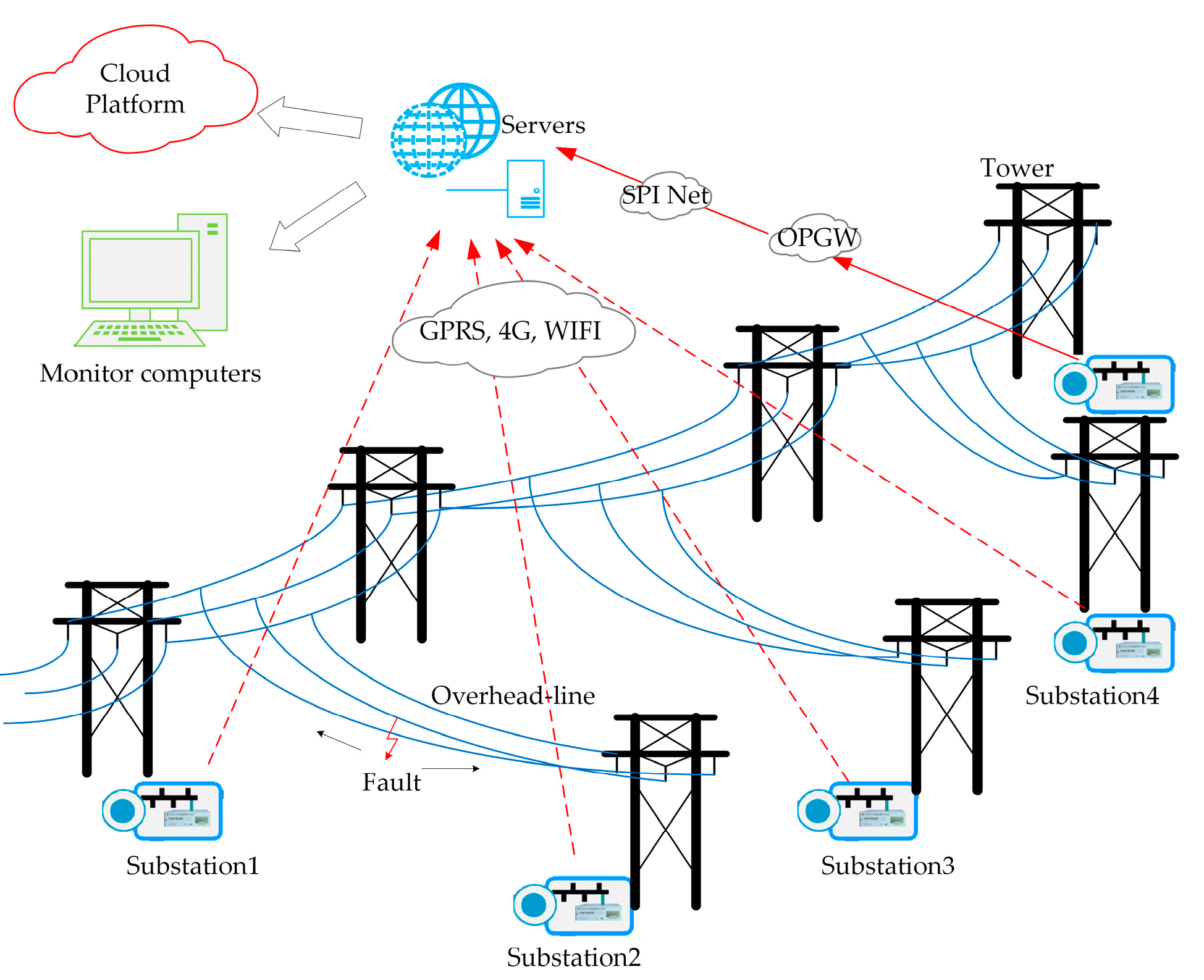
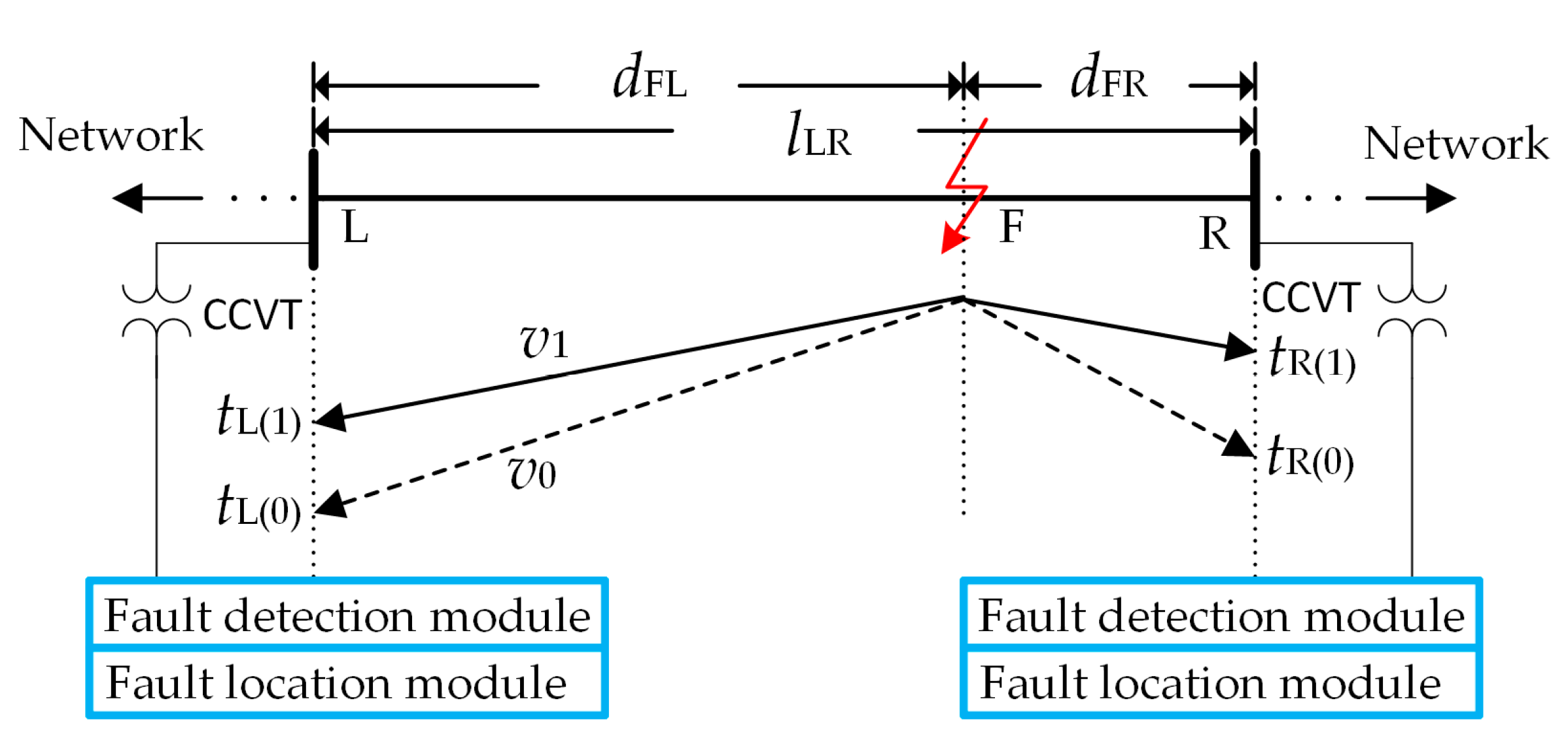



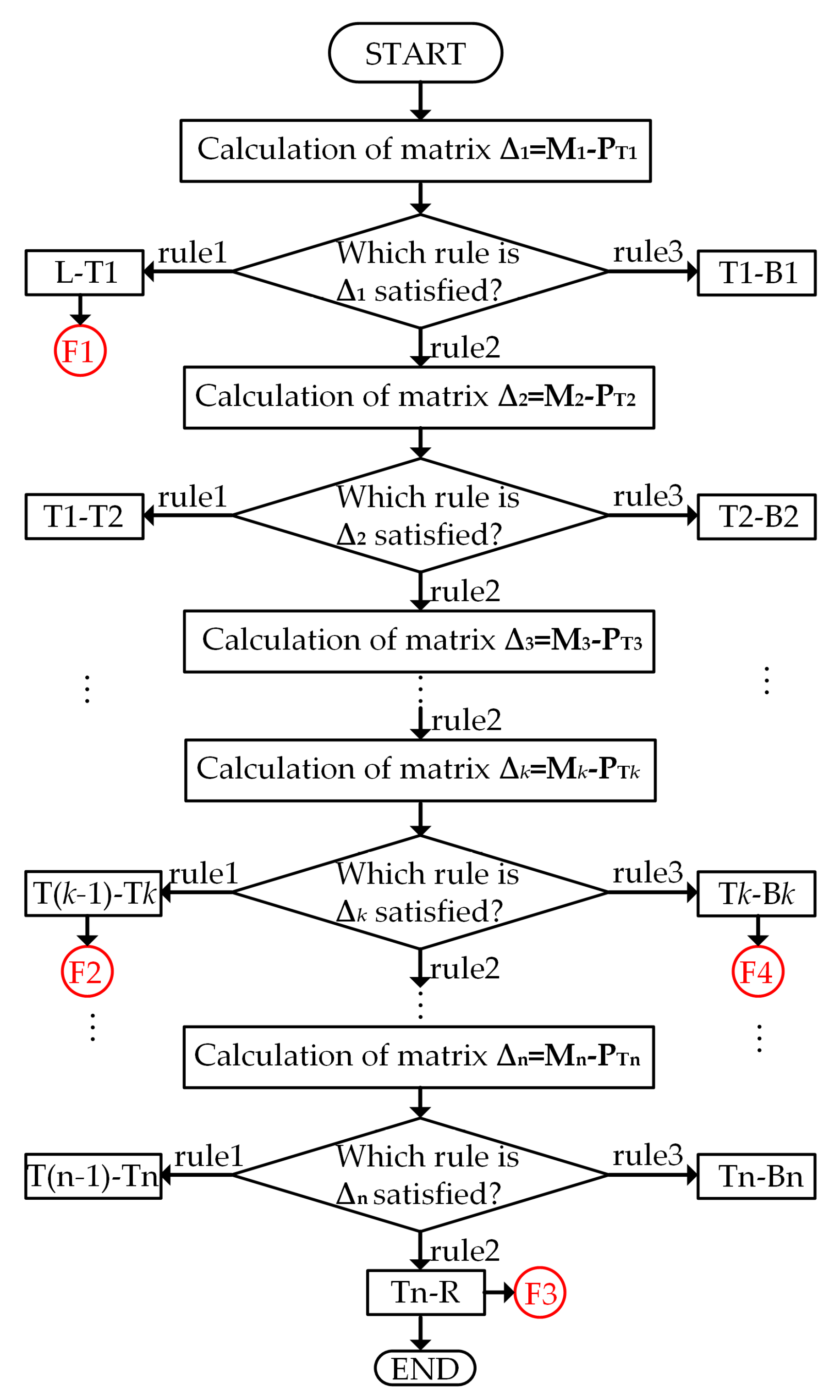
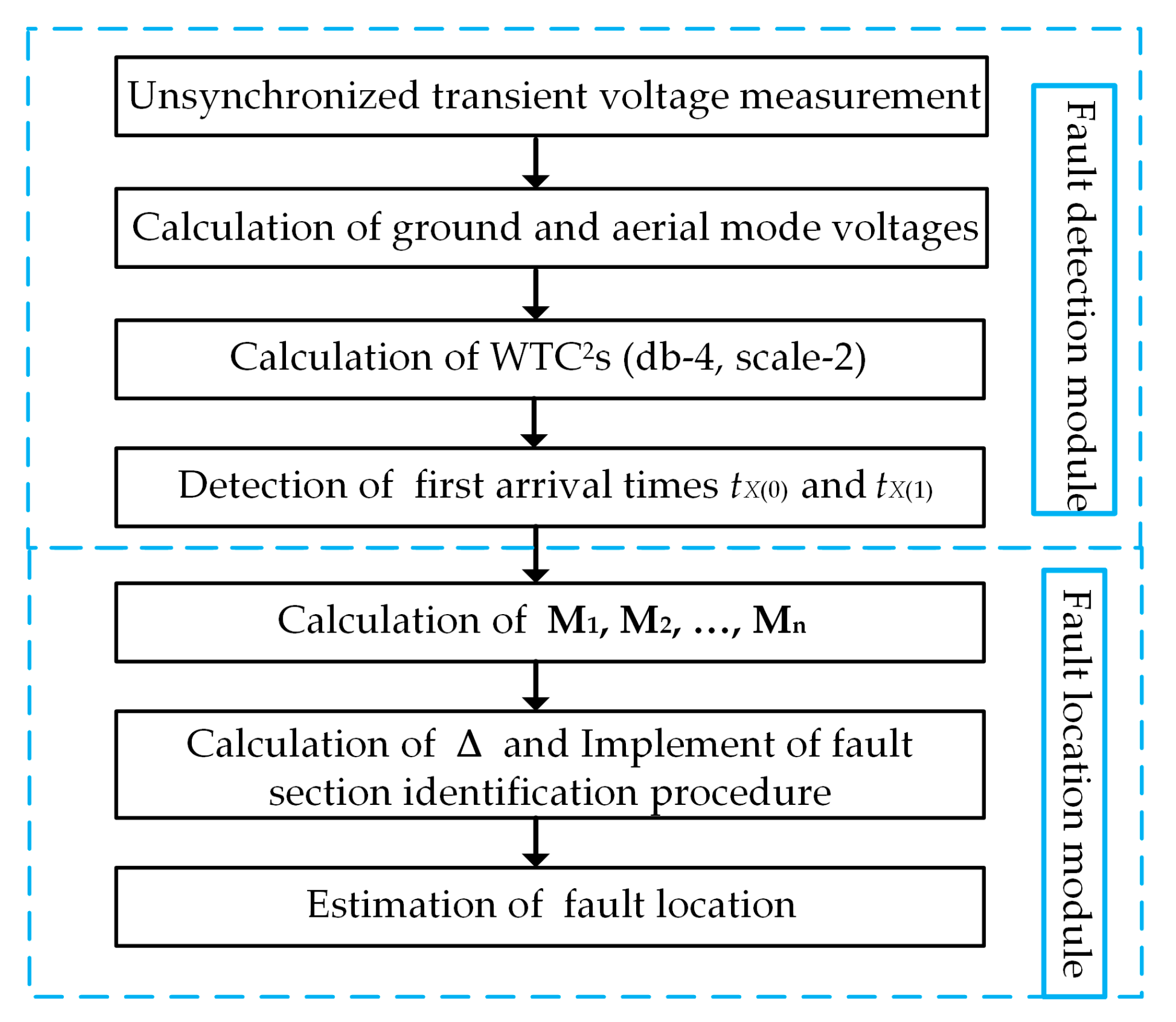

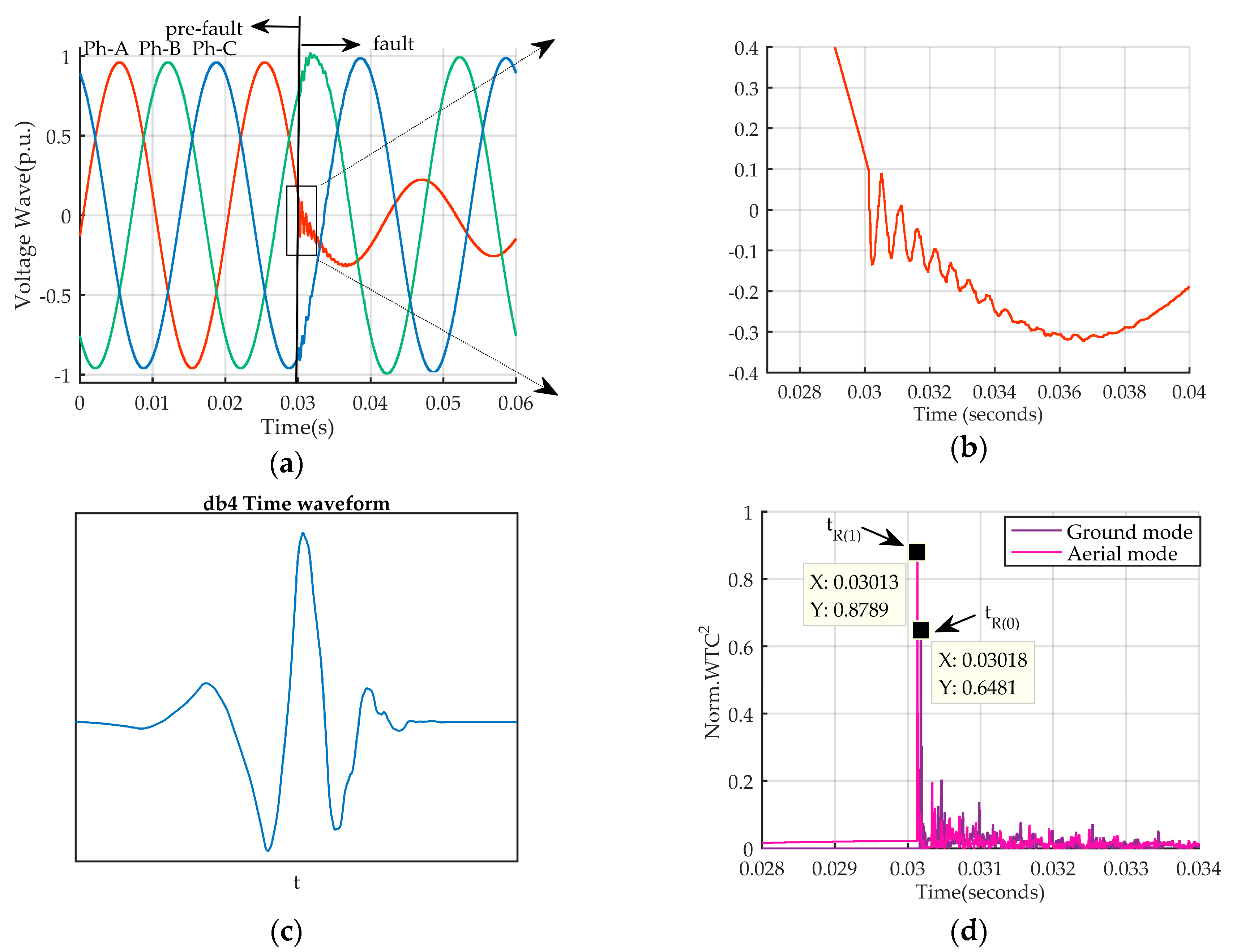


| Fault Section | L–T | R–T | B1–T |
|---|---|---|---|
| Rules | rule 1: | rule 2: | rule 3: |
| Parameters Type | Values |
|---|---|
| Source (p.u.) | EL = 1.04∠20°, EB1 = 1.02∠10°, EB3 = 1∠0°, ER = 0.98∠−10° EB3 = 1∠0°, ER = 0.98∠−10° |
| Lines | Z0 = 0.362 + j1.1426 (Ω/km), Y0 = j1.936 × 10−6 (S/km) Z1 = 0.035 + j0.4234 (Ω/km), Y1 = j2.726 × 10−6 (S/km) |
| Loads | Load1: 65 MW + 15 MVAR, Load2: 80 MW |
| Line Length (km) | lT1L = 120, lT1T2 = 60, lT2T3 = 90, lT3R =30, lT1B1 = 80, lT2B2 = 50, lT3B3 = 100 lT1B1 = 80, lT2B2 = 50, lT3B3 = 100 |
| BDRM | ,, |
| Fault Distance Ratio | rLR = 7.78, rLB1 = 1.19, rLB2 = 2.00, rLB3 = 2.50, rRB1 = 0.15, rRB2 = 0.26, rRB3 = 0.32 rRB1 = 0.16, rRB2 = 0.26, rRB3 = 0.33, lT1B1 = 80, lT2B2 = 50, lT3B3 = 100 |
| FDRM | ,, |
| Fault Location | lFL (km) | Fault Section | dFL (km) | Err (%) |
|---|---|---|---|---|
| 5% of lT1L | 6 | L–T1 | 6.09 | 0.017 |
| 55% of lT1L | 66 | L–T1 | 65.84 | 0.030 |
| 95% of lT1L | 114 | L–T1 | 113.62 | 0.072 |
| 15% of lT1T2 | 129 | T1–T2 | 128.57 | 0.081 |
| 45% of lT1T2 | 147 | T1–T2 | 146.89 | 0.021 |
| 85% of lT1T2 | 171 | T1–T2 | 171.45 | 0.085 |
| 10% of lT2T3 | 189 | T2–T3 | 188.17 | 0.156 |
| 50% of lT2T3 | 225 | T2–T3 | 225.40 | 0.075 |
| 90% of lT2T3 | 261 | T2–T3 | 261.53 | 0.100 |
| 20% of lT3R | 276 | T3–R | 276.57 | 0.107 |
| 40% of lT3R | 282 | T3–R | 281.74 | 0.049 |
| 80% of lT3R | 294 | T3–R | 293.90 | 0.019 |
| 5% of lT1B1 | 124 | T1–B1 | 124.24 | 0.045 |
| 35% of lT1B1 | 148 | T1–B1 | 147.63 | 0.070 |
| 75% of lT1B1 | 180 | T1–B1 | 180.30 | 0.056 |
| 10% of lT2B2 | 185 | T2–B2 | 183.97 | 0.194 |
| 30% of lT2B2 | 195 | T2–B2 | 195.16 | 0.030 |
| 70% of lT2B2 | 215 | T2–B2 | 214.77 | 0.043 |
| 5% of lT3B3 | 275 | T3–B3 | 275.55 | 0.104 |
| FIA (°) | Rf (Ω) | F1-Type | F2-Type | F3-Type | F4-Type |
|---|---|---|---|---|---|
| 55% of lT1L | 50% of lT2T3 | 40% of lT3R | 65% of lT3B3 | ||
| 10 | 10 | 0.039 | 0.080 | 0.056 | 0.027 |
| 50 | 0.041 | 0.083 | 0.059 | 0.030 | |
| 100 | 0.052 | 0.095 | 0.067 | 0.043 | |
| 45 | 10 | 0.032 | 0.077 | 0.049 | 0.022 |
| 50 | 0.035 | 0.079 | 0.053 | 0.026 | |
| 100 | 0.048 | 0.086 | 0.061 | 0.039 | |
| 90 | 10 | 0.028 | 0.072 | 0.045 | 0.021 |
| 50 | 0.030 | 0.075 | 0.049 | 0.023 | |
| 100 | 0.043 | 0.082 | 0.057 | 0.034 |
| Value | Sources of Errors | Method | ||
|---|---|---|---|---|
| ε | δ | [23] | Proposed Method | |
| Err (%) | - | - | 0.082 | 0.075 |
| √ | - | 0.104 | 0.075 | |
| - | √ | 8.936 | 0.075 | |
| √ | √ | 10.025 | 0.075 | |
© 2018 by the authors. Licensee MDPI, Basel, Switzerland. This article is an open access article distributed under the terms and conditions of the Creative Commons Attribution (CC BY) license (http://creativecommons.org/licenses/by/4.0/).
Share and Cite
Wang, D.; Ning, Y.; Zhang, C. An Effective Ground Fault Location Scheme Using Unsynchronized Data for Multi-Terminal Lines. Energies 2018, 11, 2957. https://doi.org/10.3390/en11112957
Wang D, Ning Y, Zhang C. An Effective Ground Fault Location Scheme Using Unsynchronized Data for Multi-Terminal Lines. Energies. 2018; 11(11):2957. https://doi.org/10.3390/en11112957
Chicago/Turabian StyleWang, Dazhi, Yi Ning, and Cuiling Zhang. 2018. "An Effective Ground Fault Location Scheme Using Unsynchronized Data for Multi-Terminal Lines" Energies 11, no. 11: 2957. https://doi.org/10.3390/en11112957
APA StyleWang, D., Ning, Y., & Zhang, C. (2018). An Effective Ground Fault Location Scheme Using Unsynchronized Data for Multi-Terminal Lines. Energies, 11(11), 2957. https://doi.org/10.3390/en11112957





